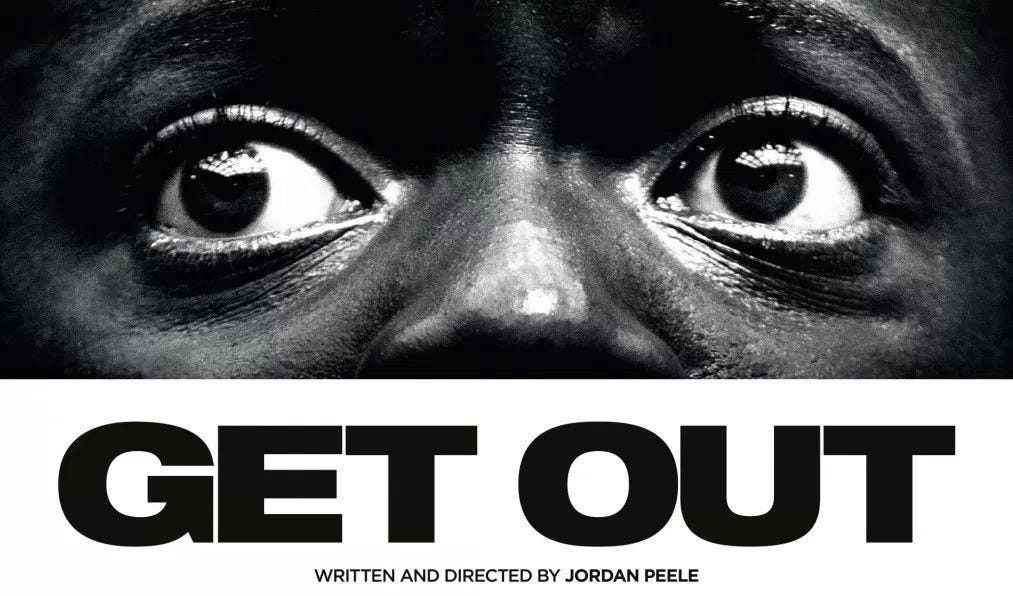A deep-dive into Get Out: A series in five parts - Quintet Part 1 - The opening 10 minutes
In the upcoming quintet of posts about the 2017 Jordan-Peele directed film Get Out which was nominated for four Academy Awards in 2018, you’ll see me do a very thorough breakdown of nearly all of its scenes. There is a lot to go over and to be frank I’m still not very certain that I have denuded all the richness contained in every detail of the film. Every successive watch I grasp something I had not before. This among many other elements keeps the experience of rewatching the movie several times over very far removed from stale. It has this tendency to smack you in the face with your incomplete understanding of the film from your previous watches. The film compels close attention both to itself and the daunting message it assaults your delusional conception of contemporary social reality with. Equally as well it always leaves you with a strong urge to ruminate upon what you have just been shown. And it is through this process of repeatedly reflecting on the contents of the film that I have been led to writing this quintet of analyses.
Get Out directed by Jordan Peele is spangled with scenes and minutiae that have additional, deeper and more profound layers of meaning. Each scene, every dialogue is a work of such exquisite craftsmanship they warrant careful dissection to unpack and reveal the full depth of their message that the apparent interpretation often belies. Peele himself recommends that the viewer should go watch the movie a second time shortly after their first, to witness scenes previously appearing completely mundane and insignificant take on whole new strata of meaning. It was only during my third viewing, which involved me pausing, rewinding, replaying every little scene paying careful attention and meticulous analysis to every slight movement and shift in the characters’ actions, speech and expressions, that I realised just how much I had failed to discern from my previous viewings and just how much thought had been put into the movie’s making. I’ll cite some of my my favourites in this regard to exemplify this point:
- This one’s easy to miss on your maiden watch, but something you’ll catch onto very soon during your second. It takes place inside the opening scene of the movie where we observe an African-American male walking nervously down the sidewalk in a desolate suburban neighbourhood. Some moments pass before a vintage creme-coloured Porsche passes him from the other direction. Eerily the car pulls up behind him and makes a u-turn to follow him. A masked figure suddenly enters frame from behind the man and makes the latter keel over by trapping him in a rear naked choke hold. The man of course is none other than Andre Hayworth who becomes the vessel for Logan King and the place of the crime - the suburbs - is where Chris Washington, the protagonist, is lured out to by his girlfriend. The foreshadowing for what is to come is thus set into motion through details planted in the very first scene.
- A little but fascinating detail I picked up during the intro to the second scene was of the series of striking photos in black and white overlaid with opening credits of the film. These are photos captured by none other than Chris himself and showcases his prodigious talent with the camera. The images depict small, light and playful moments in the everyday life of the normal black person in America. Perhaps Peele is telling us the message of the film relates to the everyday African American experience - that racism is an inseparable part of their day-to-day lives, a monster assimilated as part and parcel of daily life in contemporary and America.
- Midway into the second scene Chris, who is perturbed with anxiety and uneasiness at the prospect of visiting his white girlfriend’s very-white family, throws out the question to her “Do the know I’m black… You said I’m the first black guy you’d ever dated… I’m just sayin’ this is uncharted territory for them. I don’t wanna get chased off the lawn with a gun…”. Rose promptly responds to this assuring Chris that her family is not racist and that her dad would have voted Obama for a third-term if possible. Her expressions here, I realised later, are quite curious. She looks down and away and momentarily shuts her eyes while she mouths the above line. Body language analysts often tell us that liars will break eye-contact and try to hide their gaze when lying. On your initial watch you’ll likely take this as her blushing or doing it out of a feeling of embarrassment. However as the movie goes on we realise that nearly all of Rose’s actions are not what they purport to be. Moreover, Peele brilliantly throws a jab through this scene at how present day American liberals convince themselves and people around them that they’re not racist through token acts such as ‘voting for Obama’. Finally during the movie’s climax Rose herself ends up in the role to chase Chris off the lawn with a shotgun.
- As Rose and Chris are driving through the woods on the way to the Armitage family villa, Chris makes a phone call to his friend Rod. Near the end of the phone conversation Rose flippantly throws out ‘…this is all just a ploy to get to you[Rod].’ On repeat watches of the scene it quickly becomes apparent that underneath the skin of flippancy she had actually spoken the truth. As shown in the final scene of the movie Rose attempts, unsuccessfully, to seduce Rod over the phone to get him to succeed Chris as her new boyfriend or to get Rod to unwittingly walk into the their trap by trying to find Chris.
[Continued in Part 2...]

Comments
Post a Comment